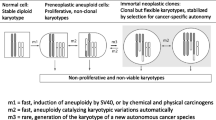Summary
-
1.
A complex type of intercellular contact, requiring cluster formation among three cells or more, is a prerequisite to growth control for a large number of established fibroblast lines.
-
2.
This form of contact occurs at lowest cell densities among cells that synthesize a specific protein that blocks intercellular WGA agglutination.
-
3.
High saturation density cells, lacking this protein, are rapidly agglutinated by WGA.
-
4.
Low saturation density cells, including a line containing SV40 T antigen and the SV40 genome, make this protein, and consequently are agglutinated poorly.
-
5.
The presence of the SV40 genome and SV40 T antigen are not sufficient to guarantee that a cell lines will have a high saturation density or that it will respond well to the WGA agglutinin.
Similar content being viewed by others
References
Westphal, H., and R. Dulbecco. 1968. Viral DNA in polyoma and SV40-transformed cell lines. Proc. Natl. Acad. Sci. U. S. A. 59: 1158–1165.
Benjamin, T., 1966. Virus-specific RNA in cells productively infected or transformed by polyoma virus. J. Mol. Biol. 16: 359–373.
Aloni, Y., E. Winocour, and L. Sachs, 1968. Characterization of the simian virus 40-specific RNA in virus-yielding and transformed cells. J. Mol. Biol. 31: 415–429.
Dulbecco, R. 1967. The induction of cancer by viruses. Sci. Amer. 216: 28–37.
Todaro, G., and H. Green, 1964. An assay for cellular transformation by SV40. Virology 23: 117–119.
Green, H., and G. Todaro. 1967. In: On the mechanism of transformation of mammalian cells by SV40. Academic Press, New York.
Pollack, R., H. Green, and G. Todaro. 1968. Growth control in cultured cells: selection of sublines with increased sensitivity to contact inhibition and decreased tumor-producing ability. Proc. Natl. Acad. Sci. U. S. A. 60: 126–133.
Rabinowitz, Z., and L. Sachs, 1968. Reversion of properties in cells transformed by polyoma virus. Nature (London) 220: 1203–1206.
Marin, G., and J. Littlefield. 1968. Selection of morphologically normal cell lines from polyoma transformed BHK hybrids. J. Virol. 2: 69–77.
Rueckert, R., and G. Mueller. 1960. Studies on unbalanced growth in tissue culture. 1. Induction and consequences of thymidine deficiency. Cancer Res. 20: 1584–1591.
Reyes, P., and C. Heidelberger. 1965. Fluorinated pyrimidines XXVI. Mammalian thymidylate synthetase, its mechanism of action and inhibition by fluorinated nucleotides. Mol. Pharm. 1: 14–30.
Fisher, H., and J. Yeh, 1967. Contact inhibition in colony formation. Science 155: 582–583.
Todaro, G., and H. Green. 1963. Quantitative studies on the growth of mouse embryo cells in culture and their development into established lines. J. Cell Biol. 17: 299–313.
Todaro, G., H. Green, and B. Goldberg. 1964. Transformation of properties of an established cell line by SV40 and polyoma virus. Proc. Nat. Acad. Sci. U. S. A. 51: 66–73.
Stoker, M., M. Shearer, and C. O'Neill. 1968. Growth inhibition of polyoma-transformed cells by contact with static normal fibroblasts. J. Cell Sci. 1: 297–310.
Eagle, H., and F. Levine, 1967. Growth regulatory effects of cellular interactions. Nature (London), 213: 1102–1106.
Kao, F., and T. Puck. 1968. Genetics of somatic mammalian cells VII. Induction and isolation of nutritional mutants in chinese hamster cells. Proc. Natl. Acad. Sci. U. S. A. 60: 1275–1281.
Luria, S., and M. Delbruck. 1943. Mutations of bacteria from virus sensitivity to virus resistance. Genetics 28: 491–511.
Sanford, K., G. Likely, and W. Earle. 1954. The development of viations in transplantability and morphology within a clone of mouse fibroblasts transformed to sarcomaproducing cellsin vitro. J. Natl. Cancer Inst. 15: 215–230.
Defendi, V., J. Lehman, and P. Kraemer. 1963. “Morphologically normal” hamster cells with malignant properties. Virology 19: 592–598.
Abercrombic, M., and E. Ambrose. 1962. The surface properties of cancer cells: a review. Cancer Res. 22: 525–548.
Aaronson, S., and G. Todaro. 1968. Basis for acquisition of malignant potential by mouse cells cultivated in vitro. Science 162: 1024–1026.
Holley, R., and J. Kernan. 1968. “Contact-inhibition” of cell division in 3T3 cells. Proc. Natl. Acad. Sci. U. S. A. 60: 300–304.
Schutz, L., and P. Mora. 1968. The need for direct cell contact in contact inhibition of cell division in culture. J. Cell Physiol. 71: 1–6.
Martz. E. 1969. Ph.D. thesis, Princeton University.
Pardee, A. 1964. Cell division and a hypothesis of cancer. Natl. Cancer Inst. Monogr. 14: 7–20.
Burger, M., and A. Goldberg. 1967. Identification of a tumor-specific determinant on neoplastic cell surfaces. Proc. Nat. Acad. Sci. U. S. A. 57: 359–366.
Burger, M. 1968. Isolation of a receptor complex for a tumor specific agglutinin from the neoplastic cell surface. Nature (London) 219: 499–500.
Pollack, R., and M. Burger. 1969. Surfacespecific characteristics of a contact-inhibited cell line containing the SV40 viral genome. Proc. Natl. Acad. Sci. U. S. A. 62: 1074–1076.
Hakomori, I., J. Koscielak, K. Bloch, and R. Jeanluz. 1967. Immunologic relationship between blood group substances and fucose containing glycolipid of human adenocarcinoma. J. Immunol. 98: 31–38.
Burger, M. M. 1968. In: L. Manson (Ed.), Biological properties of the mammalian surface membrance. Wistar Institute Symposium monograph No. 8. Wistar Press, Philadelphia.
Burger, M. 1969. A difference in the architecture of the surface membrane of normal and virally transformed cells. Proc. Natl. Acad. Sci. U. S. A. 62: 994–1001.
Pope, J., and W. Rowe. 1964. Detection of specific antigen in SV40-transformed cells by immunofluorescense. J. Exp. Med. 120: 121–128.
Gilden, R., R. Carp, F. Tajuchi, and V. Defendi. 1965. The nature and localization of the SV40 induced complement-fixing antigen. Proc. Natl. Acad. Sci. U. S. A. 53: 684–692.
Todaro, G., and K. Takemoto. 1969. “Rescued” SV40: increased transforming efficiency in mouse and human cells. In press.
Pollack. R. Unpublished experiments.
Author information
Authors and Affiliations
Rights and permissions
About this article
Cite this article
Pollack, R.E. Cellular and viral contributions to maintenance of the SV40-transformed state. In Vitro 6, 58–65 (1970). https://doi.org/10.1007/BF02616134
Issue Date:
DOI: https://doi.org/10.1007/BF02616134




